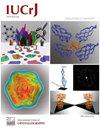使用 Phenix 和 ORCA 软件进行实空间和倒易空间的量子细化。
IF 3.6
2区 材料科学
Q2 CHEMISTRY, MULTIDISCIPLINARY
引用次数: 0
摘要
X 射线和中子晶体学以及低温电子显微镜(cryo-EM)是获得生物大分子原子结构的最常用方法。它们的一个共同特点是,在典型分辨率下,实验数据需要辅以经验约束,以确保最终结构在化学上是合理的。对于氨基酸和核酸来说,这些约束条件是准确的,但对于底物、抑制剂、小分子配体和金属位点来说,往往就不那么准确了。这可以通过量子力学计算结构中一小部分有趣的部分来解决。这种方法被称为 "量子细化"(quantum refinement),已被证明可以局部改进结构,确定配体和金属的质子化和氧化态,并区分对结构的不同解释。在这里,我们介绍了一种新的量子细化实现方法,它将广泛使用的结构细化软件 Phenix 与免费提供的量子力学软件 ORCA 相结合。通过对锰超氧化物歧化酶、V-和F-氮化酶的应用,我们展示了该方法对 X 射线和中子晶体结构的有效作用,旧的结果可以重现,并且可以进行结构判别。我们讨论了如何选择实验数据和经验约束之间的权重系数,以及如何计算应变能等量子力学质量度量。我们还介绍了量子细化在微粒甲烷单加氧酶低温电子显微镜数据中的应用,并表明这可能是此类结构中金属位点的首选方法,因为目前还没有针对金属的精确经验约束。本文章由计算机程序翻译,如有差异,请以英文原文为准。
Quantum refinement in real and reciprocal space using the Phenix and ORCA software
We present a new implementation of quantum refinement interfacing the widely used Phenix and ORCA software. We show applications on a neutron structure of Mn superoxide dismutase, X-ray structures of V- and Fe-nitrogenase and a cryo-EM structure of particulate methane monooxygenase.
X-ray and neutron crystallography, as well as cryogenic electron microscopy (cryo-EM), are the most common methods to obtain atomic structures of biological macromolecules. A feature they all have in common is that, at typical resolutions, the experimental data need to be supplemented by empirical restraints, ensuring that the final structure is chemically reasonable. The restraints are accurate for amino acids and nucleic acids, but often less accurate for substrates, inhibitors, small-molecule ligands and metal sites, for which experimental data are scarce or empirical potentials are harder to formulate. This can be solved using quantum mechanical calculations for a small but interesting part of the structure. Such an approach, called quantum refinement, has been shown to improve structures locally, allow the determination of the protonation and oxidation states of ligands and metals, and discriminate between different interpretations of the structure. Here, we present a new implementation of quantum refinement interfacing the widely used structure-refinement software Phenix and the freely available quantum mechanical software ORCA. Through application to manganese superoxide dismutase and V- and Fe-nitrogenase, we show that the approach works effectively for X-ray and neutron crystal structures, that old results can be reproduced and structural discrimination can be performed. We discuss how the weight factor between the experimental data and the empirical restraints should be selected and how quantum mechanical quality measures such as strain energies should be calculated. We also present an application of quantum refinement to cryo-EM data for particulate methane monooxygenase and show that this may be the method of choice for metal sites in such structures because no accurate empirical restraints are currently available for metals.
求助全文
通过发布文献求助,成功后即可免费获取论文全文。
去求助
来源期刊

IUCrJ
CHEMISTRY, MULTIDISCIPLINARYCRYSTALLOGRAPH-CRYSTALLOGRAPHY
CiteScore
7.50
自引率
5.10%
发文量
95
审稿时长
10 weeks
期刊介绍:
IUCrJ is a new fully open-access peer-reviewed journal from the International Union of Crystallography (IUCr).
The journal will publish high-profile articles on all aspects of the sciences and technologies supported by the IUCr via its commissions, including emerging fields where structural results underpin the science reported in the article. Our aim is to make IUCrJ the natural home for high-quality structural science results. Chemists, biologists, physicists and material scientists will be actively encouraged to report their structural studies in IUCrJ.
 求助内容:
求助内容: 应助结果提醒方式:
应助结果提醒方式:


